In our last several posts, here and here, we have discussed the famous Hampton Court conference, which ultimately lead to the creation of the King James Bible. One or two more posts on the conference will be forthcoming, but along the way it seems appropriate to say a word about the primary sources used for studying the conference. Those without interest in such detailed historical investigation can simply skip this post and move to the next one.
The Lying Barlow?
The longest and most well-known account of the conference is the semi-official, The Sum and Substance of the Conference by dean of Chester William Barlow. Regular spokesman for and defender of episcopacy, he would go on to serve as a Translator for the KJB, and as head of the Second Westminster Company which worked on the KJB Epistles (Romans-Jude). C. S. Knighton summarized (pg. 2) Barlow’s attendance at the conference and the writing of the account, explaining that, “by 8 May Barlow had been chosen dean of Chester, as which he was installed on 12 June.” Yet:
This office (perhaps reflecting his origins in the north-west) had little claim on his attention; its chief importance was that it gave him status to attend the Hampton Court conference of 14–18 January 1604. Barlow was commissioned to write the official account of these proceedings, in which the hierarchy confronted its puritan critics, with the king in the chair. Publication was delayed by Whitgift’s death (29 February). On 12 May Barlow invited Cecil to accept the dedication, but the latter prudently asked to see the text first, and then avoided Barlow until the book had gone to press. Bancroft, the king’s secretary (Sir Thomas Lake), and the king himself allegedly approved Barlow’s draft, which appeared on 25 May as The Summe and Substance of the Conference (1604; STC 1456).
However, as it came off the press, “It was immediately criticized for misrepresentation; in particular, for making the king side comprehensively with the bishops.” This wasn’t news to Barlow. Knighton continues, “He had foreseen controversy,” offering as a disclaimer that he was only giving the “substance” of the conference, and not always recording verbatim everything said. In fact, he published as an appendix four different Puritan-slanted accounts; representatives of what he claimed to be a current bias in the opposite direction.
Trusting Barlow
Shortly, this skepticism about Barlow’s accuracy was overcome and his account came to be almost universally trusted by standard historians. Fuller noted in his 1655 history that, “Others complain that this Conference is partially set forth only by Dr. Barlow, dean of Chester, their professed adversary, to the great disadvantage of their divines” (pg. 193), yet used it as the basis for his own recasting of the conference in the form of dialogue. Strype in 1718 did likewise, suggesting (pg. 492) that it was “an authentic relation” written by Barlow “that the very truth of [the conference] may appear.” Cardwell in 1840 used Barlow as one of the main foundations of his treatment of the conference. Later in the century and after its turn, classic treatments of the conference like those by the eminent English historian S. R. Gardiner in 1883 and Roland Greene Usher in 1910 relied almost exclusively on Barlow’s account, revealing that while different interpretations of the conference had emerged, Barlow’s account had come to be accepted as a largely historically accurate picture. But would this trust last?
Doubting Barlow
Mark Curtis raised again the question in 1961, “How reliable is Barlow’s account?” He concluded that it was little more than, “a skillful piece of party propaganda.” He thus gave new prominence to the previously neglected “Anonymous Account” that had been printed in Usher (Harley MS 828), judging it “the best guide through this whole body of material,” which is “at all important points…consistent with the rest of the evidence.” He was influential and his conclusions were widely followed. Adam Nicolson, echoing Curtis without citing him, suggested that Barlow “was the official propagandist for the bishops’ cause, and his pamphlet was a carefully slanted version of events,” and even went so far as to claim boldly that, “Barlow…was lying.” Knighton represents this renewed distrust for Barlow’s account well:
The extent to which Barlow’s summary does indeed convey the substance remains central to the historiography of the conference. His report was long accepted as authentic, though differing interpretations were drawn from it. It has since been shown how he shaped his account for dramatic as well as polemical purpose. It is Barlow who gives James his famous line ‘No bishop, no king’, and who had him, riled by the advocacy of presbyterianism, bring the second day’s session to a close with the words ‘I shall make them conforme themselves, or I wil harrie them out of the land, or else doe worse’ (Barlow, Conference, 82, 83). Other testimony confirms that while the king made a spirited retort, he did not end the day on this bitter note. To an extent the truthfulness of Barlow’s version is of less consequence than the impact that it made. This lent powerful support to the view that the Stuart monarchy and the puritans were from this moment destined to collide.
Yet this distrust in Barlow prompted by Curtis may turn out to have been short lived. In 1981 Frederick Shriver pushed back against Curtis, suggesting that, “The ‘Anonymous Account’ cannot take the place of the Summe and Substance. It is far too short and far too thin….It is useful – even important – but supplementary only.” Hill pointed out that, historically, it has always been common to report the events of the conference with a certain bias. Patrick Collinson, in his earlier treatments of the conference (here and here), seemed largely to accept the judgement of Curtis, asserting that the Sum and Substance, “was itself a skillfully tendentious piece of party propaganda” (pg. 37), and a “journalistic coup” that “was not so much an exercise in fair and objective reporting as ‘a skillful piece of party propaganda'” (pg. 29). Yet in his most mature reflection on the conference before his passing, after the developments we will trace below, he came to the slightly more nuanced conclusion that, “The various accounts of the conference are all episodic and biased in one way or another, and all must be read with care” (pg. 199).
The Vindication Of William Barlow
The primary issue relates to how the king viewed the Puritan spokesmen. Did they receive a fair and impartial hearing, or was the king firmly anti-Puritan as Barlow seemed to suggest? Two recent developments have tended to vindicate Barlow as at least a moderately faithful witness.
Chaderton’s Copy Of The Sum And Substance
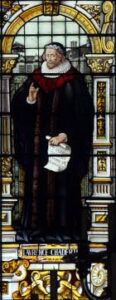
Laurence Chaderton, from the 1884 stained glass windows of Emmanuel College, in a scheme suggested by F.J.A. Hort, which emphasizes his role as preacher.
First, the recently discovered papers of Laurence Chaderton contain, among other things, his personal annotated copy of Barlow’s account. Arnold Hunt examined this document here. Chaderton was not only present at the conference on the important second day, he was also, as we noted in our last post, one of the leading spokesmen for the Puritans (whether he himself should be referred to as one is a debated point). He went on to be one of the notable King James Translators, in the First (Hebrew) Company at Cambridge which worked on I Chronicles-Song of Songs. He was educated at Christ’s College Cambridge, and was probably still a Catholic when he came, though he quickly converted to the Cambridge Protestantism. While a highly respected trilingual biblical scholar and theologian, he was perhaps most well known as a preacher and evangelist. When he gave up his weekly lecture in the pulpit at St. Clement’s Church in Bridge Street, which he had held for half a century, “forty divines signed a testimonial to the effect that they owed their conversion to his teaching” (Collinson, pg. 1).
Few could have more reason to see things differently from Barlow, and, perhaps more importantly, to contradict him in his annotations when given the chance. Indeed, among the numerous annotations he made in his copy there are a few that reveal his own memory clashing with Barlow’s printed report. Perhaps most important is in how the Puritan spokesmen were described. We noted in our last post some diverse views in characterizing these four men. Barlow had described them as “Agents for the Millenary Plaintiffs.” Yet at this point in his account, Chaderton took issue with this description, countering in the margin,
patients rather, being commanded to attend, nor but to hear [“and obey” written then crossed out] his majesty’s pleasure. God forbid we should be agents for any sect in religion or for any faction. Neither could we be for these, seeing none ever required this at our hands. No learning therefore can justify this, nor excuse the breach of charity.
[Spelling lightly updated]
For Chaderton, rather than agents they were patients, in the older sense of the word meaning, “A person who or thing which undergoes some action, or to which something is done; a (passive) recipient. Chiefly in contrast with agent.” (OED 4a). When Barlow later wrote that “the most grave, learned, and modest of the aggrieved sort” (the Puritans) were summoned by the king to the conference, Chaderton, as Hunt notes, “pounced on the contradiction,” arguing in the margin, “Being sent for how could they be agents for others? Being willed to speak how could they be plaintiffs?” As Hunt points out, “Barlow’s choice of vocabulary was clearly designed to serve a polemical purpose, but Chaderton’s efforts to disassociate himself from the puritan radicals were equally disingenuous” (pg. 212).
Some have emphasized this disagreement by Chaderton, like Collinson, who notes that Chaderton’s annotations show that he “took strong exception” to Barlow’s account (pg. 3). Yet for most, what is ultimately striking is how little he contradicts the historical scheme of Barlow. He seems to have accepted it as accurate except at a few minor points. Hunt noted that, “There is no doubt that Hampton Court was a fairly comprehensive defeat for the puritan cause,” and qualified that, “Admittedly, Barlow’s narrative may exaggerate the scale of that defeat,” but concluded that ultimately, “what Chaderton says here is arguably less significant than what he fails to say elsewhere.” The most crucial events of the conference “attracted no marginal comment” from Chaderton, and his annotated copy thus implies that at the crucial points, “Barlow’s account is a tolerably accurate record of what actually took place” (pg. 223).
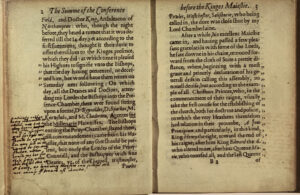
A page from Chaderton’s copy of Barlow’s work, showing an annotation disagreeing with Barlow. Photo credit – The Masters and Fellows of Trinity College, Cambridge, (C.9.125.fB1v). Worsley/Souden pg. 65.
David Norton, one of the world’s leading scholars today on the KJB, in his earlier work seemingly concurred with Curtis, cautioning that, “The accuracy of Barlow’s report is questionable. It was written at Bishop Bancroft’s request, read by the King before publication and scorned by those who were not of the Church party” (pg. 5, f.n. 3). Yet in his most recent work he seems to have been persuaded to a slightly different view by the evidence of Chaderton’s copy, noting that, “Chaderton, who was present at the conference, noted some vehement disagreements with Barlow’s designation of himself, Rainolds and two other puritans as ‘agents for the millenary plaintiffs’ (p. 2) in his copy of The Sum and Substance…but his silence on the discussion of a new translation suggests that there is nothing significantly wrong with it” (pg. 83, f.n. 6).
The Thesis Of William Craig
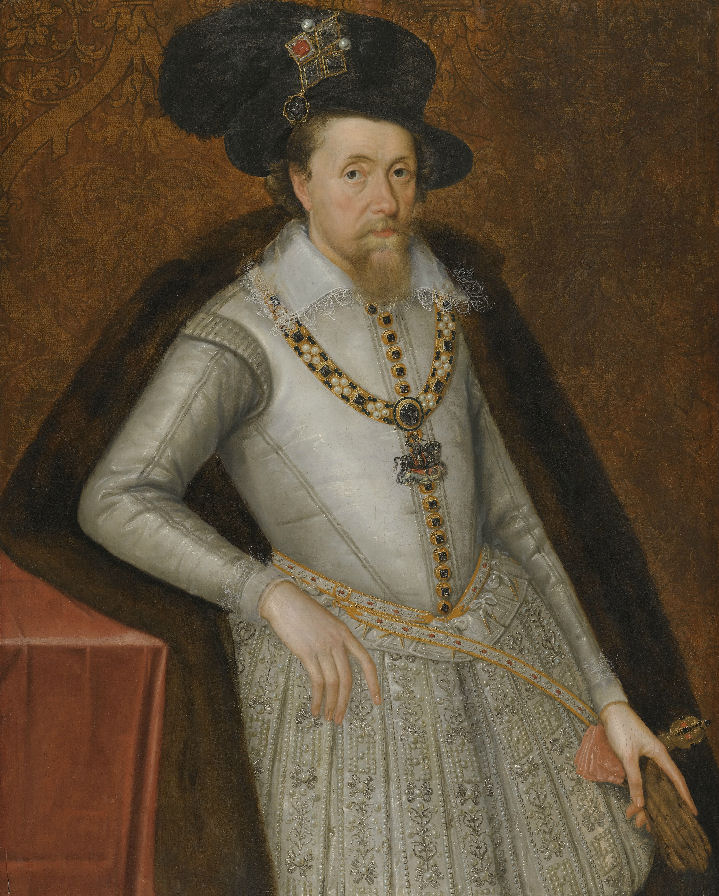
King James I, shown here in 1604, wearing the famous “Mirror of Great Britain,” by artist John de Critz, wrote a letter about the conference to Henry Howard, Earl of Northampton, towards the end of the conference.
The second development is the thesis of William Craig (noted in our last post) which examines each of the extant accounts of the conference. It is likely the most exhaustive examination of the sources to date, and it seeks to vindicate Barlow at length. Through a historical-critical analysis of the documents, Craig argues that Barlow’s account is a well-sourced eye-witness account, largely accurate (though not completely without bias), and, most importantly, corroborated by multiple outside sources at numerous decisive points. On the other hand, most of the accounts that agree with the Anonymous Account in Usher which has been championed against Barlow can be traced back to that account itself as a single source, and an anonymous one of doubtful provenance at that. The Anonymous Account itself, upon close inspection, “shows many signs of being not an eye-witness account but a composite of other earlier accounts of the conference” (pg. 246).
He thus concludes that, “Barlow’s Summe and Substance is not only indispensable because it is the longest and most detailed source we have, but also because it seems quite accurately to convey the substance of the conference” (pg. 247). In the official ODNB entry, Kenneth Fincham concurs (though apparently ignorant of Craig’s thesis), suggesting that, “Although Barlow’s account is relentlessly deferential to the king and spiky towards the puritans, it is the indispensable foundation text, three times the length of the ‘Anonymous account’ and broadly reliable, to judge from Laurence Chaderton’s annotated copy, in which he accepts large parts of Barlow’s narrative.” It would seem that, contrary to the claims of Nicolson, Barlow was not the one “lying.” The judgement of the editor of an 1804 reprinting of Barlow’s account is found to be relevant again in striking ways:
With respect to ourselves, when we consider that Bishop Barlow’s account of this famous Conference is admitted, by all parties, to be the only one set forth, and is accordingly by all parties continually quoted; that it was set forth, not upon his own authority alone, but with the assistance and allowance of several of the great men then present; that no objections to the authenticity of this account, of any consequence, were brought forward for a considerable time after it took place; and that the best of those objections were weakly and suspiciously urged, and never proved….without hesitation, we offer this Tract to the notice of the public, as well deserving attention; it has passed the ordeal of its enemies’s utmost malice, and is found to be a true and faithful work.
[Spelling lightly updated]
Extant Accounts
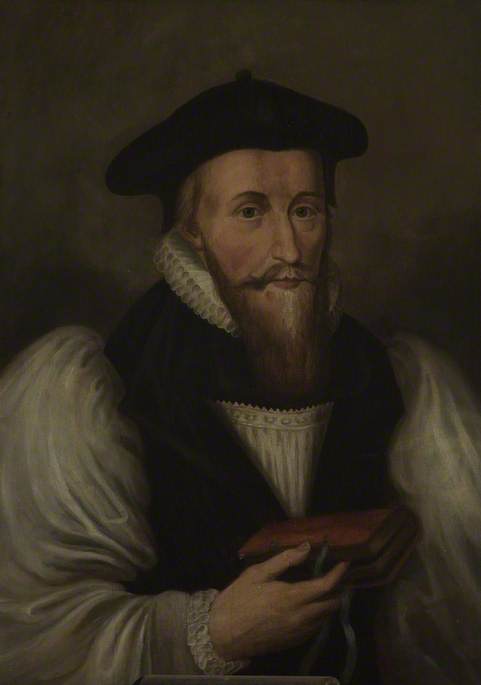
James Montagu attended the conference and wrote a letter to his mother describing it. Portrait 1608-1616. Unidentified painter.
By Craig’s count there are some sixteen different contemporary accounts of the conference, most of them short summaries in letters or diaries, nine of which come from participants or attendees of the conference, the rest of which are anonymous. For example, James Montagu, Dean of the Chapel Royal, and the first Master of Sidney Sussex College, Cambridge, attended all three days of the conference and wrote about it in a letter to his mother. Tobie Mathew, bishop of Durham, wrote a letter about the conference to Matthew Hutton, Archbishop of York. King James I himself wrote a letter about the conference to Henry Howard, Earl of Northampton. Others are noted below.
The two longest and by far the most important are the above-mentioned Anonymous Account in Usher, which paints the king as more friendly to the Puritans (British Library Harley MS 828 and Additional MS 38429), and Barlow’s, which paints him as decidedly anti-Puritan. The two accounts differ in important details. As Craig noted, “These two versions…cannot simply be harmonized into one: they present the King, the bishops, and the discussions between them in very different lights.” He categorizes the rest of the sources based on which major account they agree with. The accounts in Craig’s categories are;
- Those that agree with Barlow’s account;
- William Barlow, who took part in all three sessions, was asked to write a semi-official account, the well known, “Sum And Substance,” here. He also included three Puritan accounts which he reprinted at the end, which he shared as just samples of many going around.
- Dudley Carleton, present at Hampton Court during the conference, and probably in attendance, wrote a letter dated 15 January 1604 to John Chamberlain which gave a report of the first day of the conference (read here, pg. 53-60).
- James Montagu, Dean of the Chapel Royal, who was present for all three sessions, wrote a lengthy account in a letter to his mother on 18 Jan., the day the conference ended, printed in Cardwell, here.
- Tobie Matthew, Bishop of Durham, later Archbishop of York, wrote a letter to Matthew Hutton, Archbishop of York, the day after the conference, 19 January 1604. Printed in Cardwell, here.
- Those that agree with the Anonymous Account in Harley MSS 828;
- The Anonymous Account in Usher (British Library Harley MS 828 and Additional MS 38429) covers all three sessions of the conference.
- An anonymous letter, dated 15 January 1604 (here), also printed in Usher, covers the first day of the conference. It was the first account included as an appendix by Barlow.
- The Second Puritan account printed as an appendix in Barlow, here, covers all three days of the conference.
- Patrick Galloway wrote a letter to the presbytery of Edinburgh, dated 10 Feb. 1604. Sometimes the letter itself is claimed to have been corrected by King James himself, but as Craig points out, it is technically only the list of conclusions for which such a claim is made in the letter. Printed in Cardwell, here, in Calderwood here, and also reprinted by Gerald Bray here.
- Those that don’t give enough detail to be grouped with either;
- The Third Puritan Account in Barlow’s appendix, here, contains brief notes with little detail.
- The letter by King James I to Henry Howard, Earl of Northampton, (in Strype here, in Cardwell here, now best printed in Akrigg here, letter 101, pg. 220), presents a brief description of the king’s own take on the conference. Dated 17 Jan. 1604 by Akrigg, but 18 Jan 1604 or later by Craig.
- Thomas Sparke shared an account of the conference in “A Brotherly Persuasion To Unity And Uniformity…” STC entry here.
- Sir Roger Wilbraham, Master of Requests, recorded some details of the account in his journal. The relevant entry can be read here.
- Sir John Harington wrote a brief note with some details of the Conference, which can be read here.
- Usher printed, “An Anonymous Account in Favor of the Bishops” (not the same as the more famous Anonymous account from the Harliean manuscript above) from Baker MSS M.m.1.45, f. 155-157, here.
- Craig notes that a letter is preserved in the State Papers (14/6/37) by Ortelio Renzo, which has never been printed, which has a brief description of the Conference.
- The same letter contains a copy of another document described as “a brief note” with some brief mention of the conference.
- Craig notes that an anonymous account of the conference is found in volume IV of the Historic Manuscript Commission report on Various Manuscripts, written by F. H. T. Jervois.
It’s worth noting that a good case could be made for including the letter by King James I in the first category, clearly agreeing with Barlow. Nonetheless, I retain the categories proposed by Craig. A few other important documents are worth mentioning here again as well (other additional sources are covered in Craig’s thesis);
- The King’s proclamation 24 Oct. 1603 noting that the Conference date had been delayed – (#30 in Larkin/Hughes, here). Also in Cardwell here.
- The King’s letter 29 Oct. 1603 to Archbishop John Witgift asking how true the kinds of problems alleged in complaints, “so continually and so credibly delivered to us” (like the Millenary Petition) are (Akrigg #98).
- The King’s proclamation 5 Mar. 1604 reporting results of the council and authorizing the new prayer book (#35 in Larkin/Hughes) in Cardwell here.
- The King’s Commission 9 Feb. 1604 to the Archbishop John Whitgift detailing the minor changes that now needed to be made to the BCP. In Cardwell here.
- The canons of 1604, reflecting the changes (and especially highlighting the absence of greater changes) made after Hampton Court, in Bray here.

Tobie Matthew, Bishop of Durham, wrote a letter to the Archbishop of York about the conference the day after it ended. Unidentified painter, 1616.
We have now briefly noted each of the extant primary sources from which an examination of the Hampton Court conference must be made. We have suggested that contrary to once-commonly accepted notions, Barlow’s account is the most reliable source for reconstructing the conference, supplemented in important ways by other sources. In our next post, we will lay out a brief overview of the events of the conference, using these sources critically, before zooming in on the request for a new translation that lead to the King James Bible.
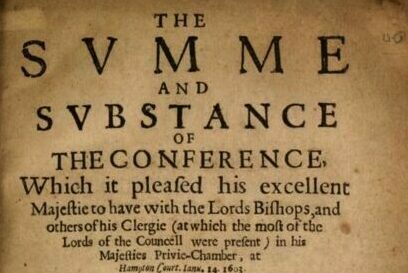

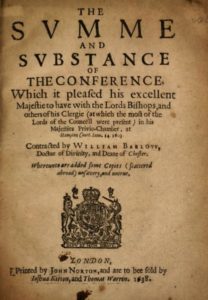
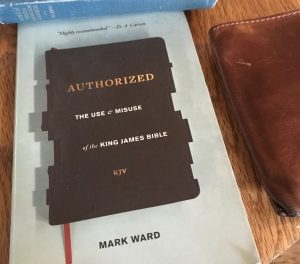
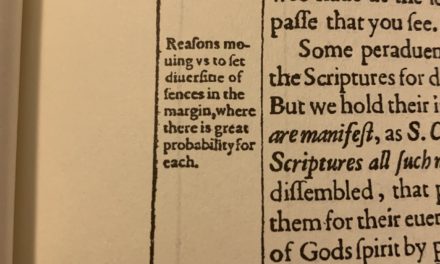
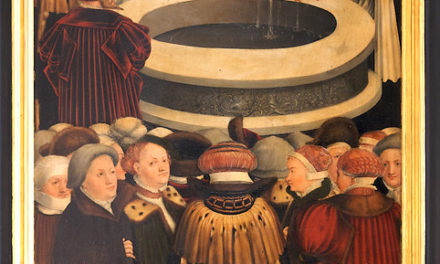
This was a fascinating read, Tim. I knew the basics but was unaware of many of the details you researched. I guess the last two parts might not get finished? I was especially interested in this because my gut tells me that the Puritans would rather have stuck with the Geneva. Yet because a translation had to be authorized; and the previously authorized Bishop’s Bible was unacceptable to the Puritans; and because the Geneva was unacceptable to James; that perhaps Rainolds felt (on his own, not the rest of the Puritans) that a new uniform, authorized translation was the only solution that worked for everyone.
I’ve heard some people say, without this context, that the Puritans petitioned for a new translation, and I think that’s too simplistic a view that doesn’t take into account the complex situation. Anyway, even if you don’t finish the other planned articles, this was well-worth reading. Thank you!
Logan,
Thanks! Sorry of the delay in replying. I think the Puritans did have a great love for the Geneva Bible (a point I will discuss some in an upcoming post). I actually will argue, following Cameron MAcKenzie, that after 1575 the Geneva Bible was an authorized translation. It just wasn’t authorized for use in public liturgy. As to what exactly Rainolds was getting at, and what motivated him, I think you are exactly right. Common answers are too simplistic. I intend eventually to explore what I hope will be a much more complex and nuanced take. Thanks for reading!
– Tim